Spotlight: Rick Olivier’s Zydeco Portraits
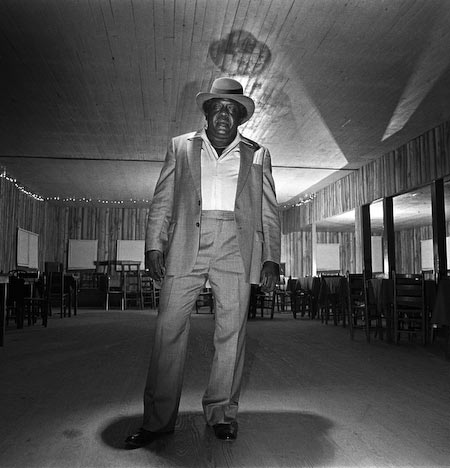
Just like the blues, zydeco is a genuinely American style of music, but unlike the blues, it never gained much of an exposure - despite the occasional hit single or the occasional brief spark of interest because of some movie. Photographer Rick Olivier portrayed many of its practitioners for a book about ten years ago, and many of his subjects have since passed on. I saw his body of work in New Orleans just a little while ago, and I’m glad he agreed to sharing some of the photos and stories.
About the photo at the top of this post, Rick writes: “Access is crucial in documentary work, and the way I got compelling subjects like Dieudonne ‘Double D’ Dauphine to pose for me was to show them pictures of the zydeco stars I had already photographed, which calmed most (but not all) of their suspicions. Of course, I had to promise to mail them prints, which I unfailingly did. I still marvel at the beauty of these interiors, most of which functioned as mid-century ‘Chitlin’ Circuit’ blues clubs that hosted legends ranging from Champion Jack Dupree to Bobby Bland and Johnny Taylor. Sadly, most of these clubs like The Double D (in Parks, LA) have been shuttered. The D-Man cut a mean figure with his popped collar and homburg so it was only natural that I place him under the ubiquitous bare light bulb and bottom light him with the fill flash. I may have actually begged to make his picture. ‘Love Hath No Pride’ ‘n all that…”
Here are more of Rick’s photos and the captions he wrote for them:
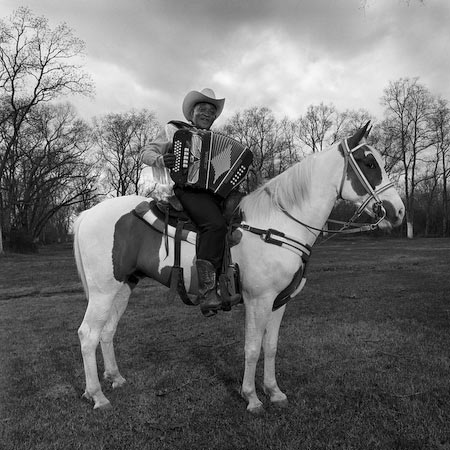
“Boozoo Chavis had the first zydeco ‘hit’ back in 1956 with a song called ‘Paper In My Shoe’, a song about ballin’ through life with homemade paper innersoles. Suspicious over lack of royalty payments he promptly retired from playing music for the next 30 years and trained champion racehorses instead. This image (in color) was used as the cover of his ‘Zydeco Trail Ride’ album. The thrill I felt going to ‘Dog Hill’ (his compound outside of Lake Charles, LA, mentioned in many of his songs, as in ‘fine, fine women, live in Dog Hill’) to photograph him was surpassed only by the quality of gumbo prepared by his wife, Leona (also mentioned in several of his songs).”
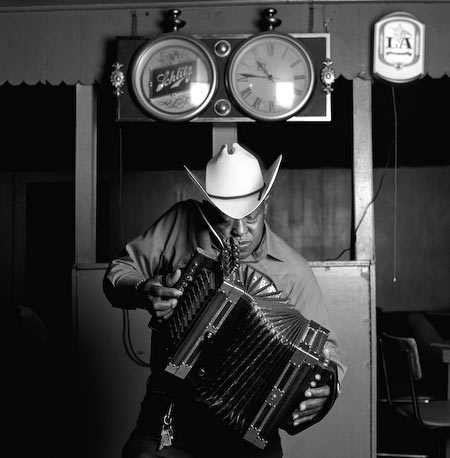
“Several of the images in my ‘Zydeco!’ book were shot on the first night I ever walked into a zydeco club. I was summoned to Richard’s Club in Lawtell, LA, to photograph a live recording for Rounder Records, and upon entering the club I experienced an overwhelming delight at the cultural and visual goldmine that was mid-1980’s zydeco. After the gig I set up a small strobe and Boozoo simply got his accordion and started playing (solo) exactly where he should be. I recall actually holding my breath in the dark club as I triggered the Hasselblad and thinking: ‘Dear God, please let these be in focus and not underexposed.’ The beer clocks were arranged within the strange painted plywood window like a Rauschenberg construction, and in just one frame Boozoo’s cowboy hat and s-curve accordion reached a visual synch with the dangling key chain. The ‘LA’ (light alcohol but also a ‘Louisiana’ abbreviation) sign at right placed us deep in the bowels of Louisiana homegrown culture and would later reappear in various versions in other clubs and photographs.”
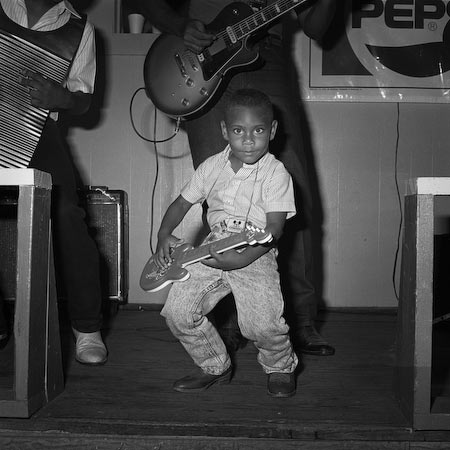
“Zydeco, like most ‘folk’ music, is verbally/musically transmitted from generation-to-generation without written transcription. Young players like Gerard Delafose (now in his mid-20’s) will often accompany their fathers, brothers, and uncles to gigs so the education begins early. This was shot at a John Delafose (his grandfather) gig at Richard’s and I made less than a dozen exposures that night. Sometimes I didn’t even take out the camera after my two hour drive. (I’m not one to shoot simply because I’m there.) Throughout this project signs kept elbowing their way into my frame that often synched perfectly to the subject. The cropped Pepsi sign at right contains an encircled ‘R’ below the capitalized ‘PEP’ to read figuratively as ‘pepper’, a description that definitely fit the 6-year-old Gerard. I recall the Eunice Playboys being pretty hot that night, too.”

“‘Papa Paul’ Goodly had only one request (translated from Creole French to me by his granddaughter) when I entered his Mamou, Louisiana, club to make his portrait and that was for his dog, Jack, to be included in the picture. As a dog owner I was happy to comply. I couldn’t resist opening the ‘Men!’ room door (most of the collectors who have purchased this print from me have been women) and framing in much of the beautifully ramshackle texture: fake brick, code violations, and the ubiquitous hanging bare bulb. A gig poster for another of Mr. Paul’s grandchildren, ‘Miss Ann Goodly’, hangs over his shoulder. Diane Arbus was right on when she stated that photography was a way to pay attention to people and most people enjoy the attention.”
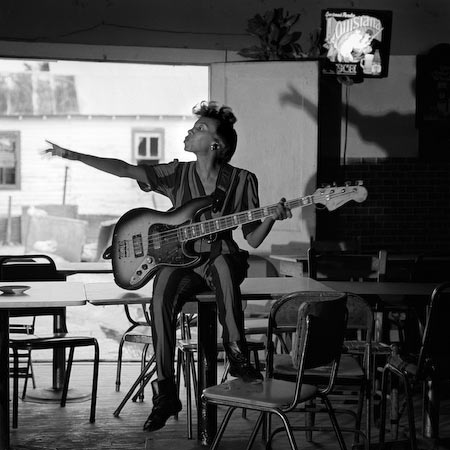
“Zydeco is full of family bands. Sandra Serile played bass for Delton Broussard and several of his sons’ bands. Her brother Jimmy was a talented scrubboard player known for his skew-legged breakdowns onto the dancefloor while playing. This picture shows the incredible freedom one can have while shooting within the confines of the ‘documentary’ project. It became second nature for me to frame symbolic signage in the clubs, open doors to expose the surrounding landscape, and put my lights in unconventional places. Set up and watch, or suggest a pose, while stuff happened. The mad style these folks routinely rocked still knocks me out. But I never anticipated how fragile this culture would be. Most of these clubs are long gone, many of the players have retired or passed on. It all disappeared much too quickly.”
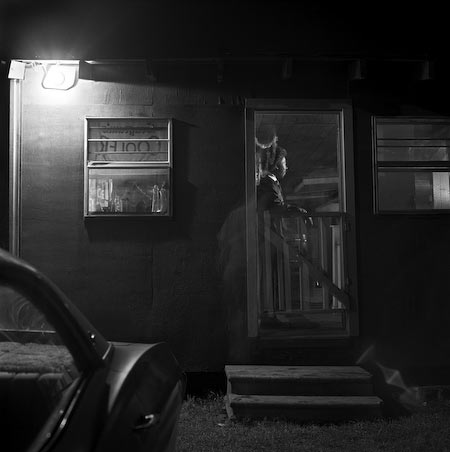
“Amedee’ was a constant and mostly-silent presence at Richard’s (‘ree-shards’) Club throughout the ‘80’s. He drove a low-slung ‘79 Chevy Bel-Air (seen frame left, shag carpet on the back dash) and helped owner Kermon Richard clean up after riotous weekend gigs. His totally sweet disposition and dapper leisure suits made him a perfect subject for a portrait I had in mind using the ‘Cooler’ sign Kermon hung up as a window curtain. Tri-X, f32, a tripod, and hand-held flash allowed me to open the shutter, run inside (I was wearing my uniform of white t-shirt/jeans) and pop the flash, then run back out and close the shutter. For me, this is photographic ecstasy. The bare light bulb became my talisman, stale beer and cigarette smoke my incense, the legendary zydeco clubs of the former ‘Chitlin Circuit’ my hallowed ground.”